7 Best Wordly AI Alternatives for Live Translation
.webp)
Wordly AI has become a popular choice for real-time translation and captions during global meetings and events. It helps participants follow conversations in their own language and makes communication more inclusive. But while Wordly AI is strong, it’s not the only option available.
What Is Wordly AI and What Does It Do?
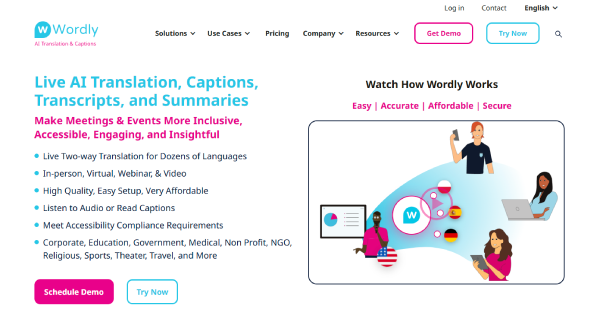
Wordly AI is a cloud-based platform that provides real-time translation and transcription for meetings, webinars, and live events. Its goal is to help people from different language backgrounds communicate seamlessly without the need for human interpreters.
With Wordly AI, participants can:
- See live captions and subtitles in their preferred language.
- Access real-time translations for spoken content.
- Join conferences, town halls, or virtual meetings and instantly understand speakers, regardless of language.
Wordly AI is particularly popular for businesses, enterprises, and event organizers who need a scalable solution for multilingual communication. It focuses on inclusivity and accessibility, making sure that everyone in a global audience can follow the conversation.
What Makes a Good Wordly AI Alternative?
When evaluating alternatives, here are the factors that matter most:
⚡ Real-time performance: Minimal lag, smooth captions, natural translations.
🎯 Accuracy: Handles multiple languages, accents, and technical terms well.
🌍 Scalability: Works for both small team meetings and large international events.
♿ Accessibility features: Live captions, subtitles, and dubbing for inclusivity.
🔌 Integrations: Works seamlessly with tools like Zoom, Teams, or Google Meet.
💰 Cost flexibility: Options for startups, enterprises, and event organizers alike.
7 Best Real-Time Alternatives to Wordly AI
1. Maestra AI
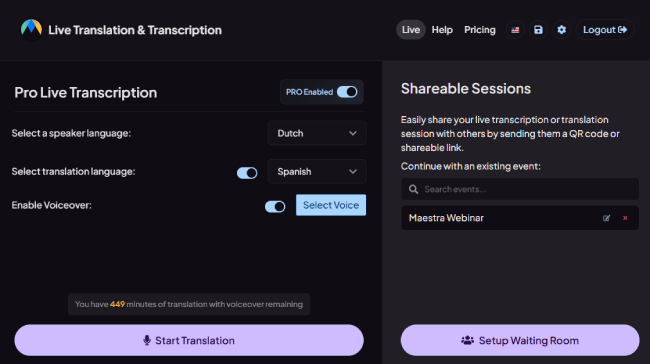
Review:
As part of Maestra AI, the setup is straightforward — real-time captions popped up instantly during meetings, and the translations felt smooth and natural. What stands out is the breadth of languages and the fact that it works equally well for both live events and repurposing recorded content. In addition, the live translator has real-time dubbing and voice cloning, and multilingual sessions where participants can choose from a multitude of languages to choose from, which are features you can't really find almost anywhere.
Pros
- Multilingual session sharing with live captions and dubbing
- Real time voice cloning and repurposable captions
Cons
- A subscription is required to use advanced solutions.
- Needs an internet connection to use.
2. KUDO
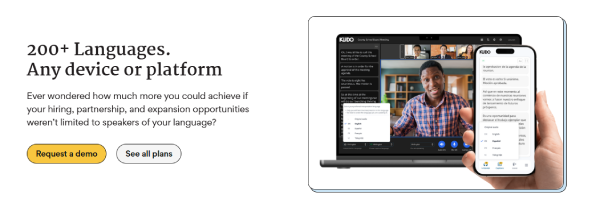
Review:
I used KUDO during a multilingual webinar, and what impressed me was the option to switch between AI and human interpreters. The transitions were seamless, and attendees could easily follow in their preferred language. It definitely feels enterprise-grade.
Pros
- Hybrid model (AI + human interpretation).
- Reliable for large, multilingual events.
Cons
- Pricing is tailored for enterprises, less ideal for smaller teams.
- Overkill if you only need simple captions or translations.
3. Interprefy
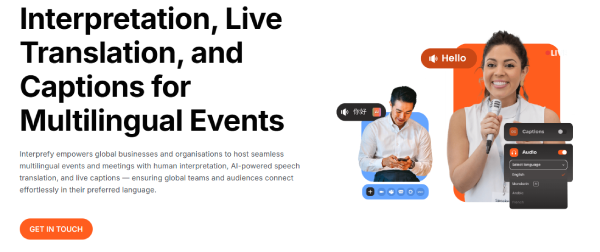
Review:
Interprefy felt polished when I joined a global event through it. The captions were quick, and the interpretation was handled professionally. It’s very event-focused, so it shines when used in big conference settings rather than small team meetings.
Pros
- Enterprise-ready for conferences and international events.
- Offers both AI and human fallback for accuracy.
Cons
- Less useful for smaller, everyday meetings.
- Pricing not transparent, usually enterprise packages.
4. Zoom AI Companion
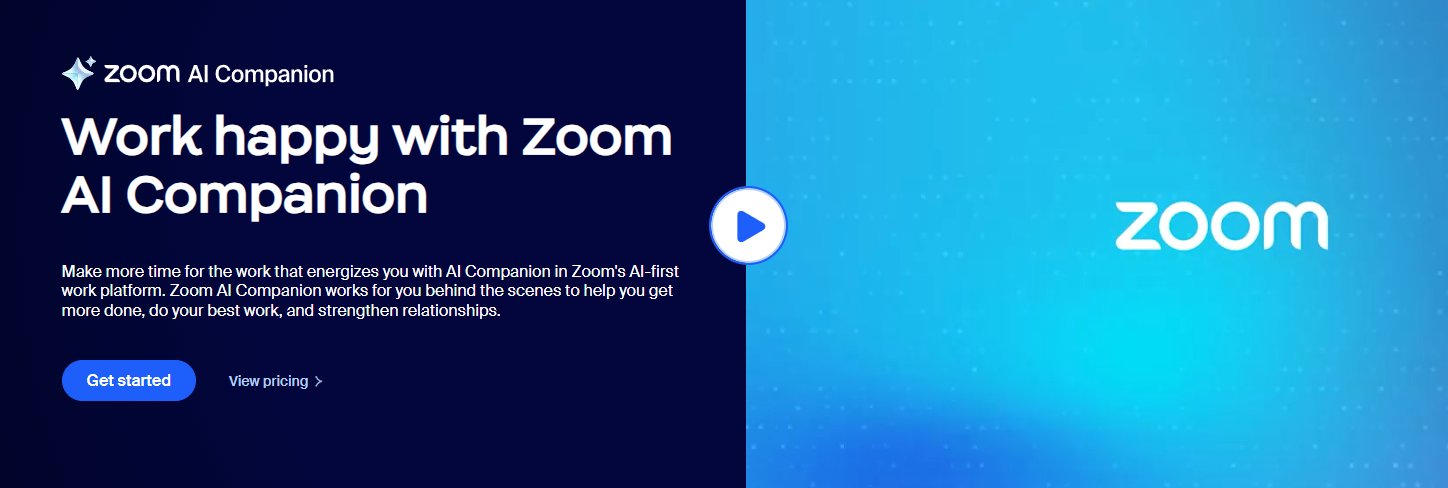
Review:
Using Zoom AI Companion is as simple as turning on captions in Zoom. The translations were fairly accurate for general conversation, and I liked how seamless it was since no extra software was needed. However, it doesn’t match the depth of dedicated solutions like Maestra or KUDO.
Pros
- Built directly into Zoom, no setup required.
- Real-time captions and translations are included in many plans.
Cons
- Limited to Zoom users, no cross-platform flexibility.
- Accuracy can dip for specialized jargon or less common languages.
5. Microsoft Teams (Live Captions & Translations)
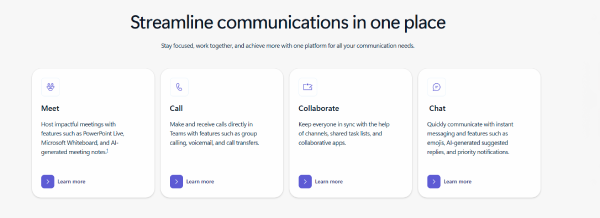
Review:
With Teams, the live captions appear in real time, and translations work smoothly when multiple languages are spoken. I found it most useful in large corporate meetings where everyone was already within the Microsoft ecosystem.
Pros
- Seamless integration for Microsoft 365 enterprises.
- Easy to use with no extra tools needed.
Cons
- Language options are more limited than dedicated platforms.
- Not ideal if you need dubbing or advanced event features.
6. Google Meet (Captions & Translation)
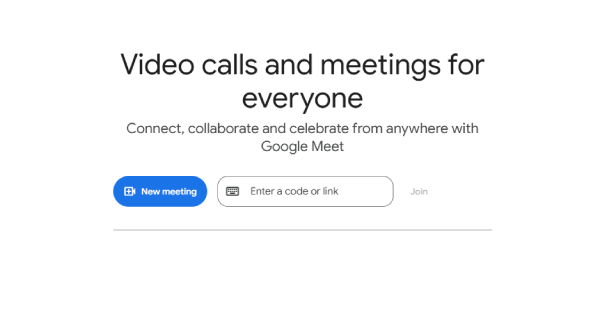
Review:
Google Meet’s live captions are surprisingly accurate for a built-in feature. I tried the real-time translation during a call, and while basic, it was good enough for everyday conversations. It’s a simple solution that works well for small and mid-sized teams.
Pros
- Free and included in Google Workspace.
- Quick, one-click enablement during meetings.
Cons
- Limited advanced functionality compared to event-focused tools.
- Not suitable for large-scale international conferences.
7. Interactio
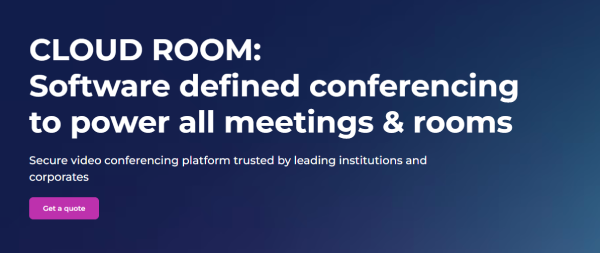
Review:
I tested Interactio during a hybrid conference, and the tool worked flawlessly. The live captions were fast, and the translations were accurate even with multiple speakers. It’s clearly built for NGOs, international organizations, and events with diverse audiences.
Pros
- Trusted by global institutions like the EU Parliament.
- Strong focus on accessibility and event-grade reliability.
Cons
- Geared toward events, not everyday business meetings.
- Pricing is designed for institutions, less for small teams.
Comparison Table of Best Wordly AI Alternatives
| Platform | Real-Time Captions | Live Dubbing | Translations | Scalability | Integrations | Best For |
| Wordly AI | ✅ | ✅ | ✅ | High | Medium | Events/Meetings |
| Maestra AI | ✅ | ✅ (with live voice cloning) | ✅ (125+) | High | Broad | Events, Content |
| KUDO | ✅ | ❌ | ✅ (AI + Human) | High | Event-focused | Large Events |
| Interprefy | ✅ | ❌ | ✅ | High | Event-focused | Conferences |
| Zoom AI | ✅ | ❌ | ✅ | Medium | Zoom Native | Zoom Users |
| Microsoft Teams | ✅ | ❌ | ✅ | Medium | Teams Native | Enterprise |
| Google Meet | ✅ | ❌ | ✅ | Medium | G-Suite | Small Teams |
| Interactio | ✅ | ❌ | ✅ | High | Event Tools | NGOs, Global Orgs |
How to Choose the Right Alternative to Wordly AI
- For small teams: Google Meet or Zoom AI may be all you need.
- For enterprises already tied into Microsoft 365: Microsoft Teams is the most seamless choice.
- For global events and conferences: KUDO, Interprefy, or Interactio deliver enterprise-grade reliability.
- For all-around real-time + content creation needs: Maestra stands out with its broad feature set.
Conclusion
Wordly AI is a strong solution for real-time translation, but there are plenty of alternatives that might fit your needs better.
If you want a platform that goes beyond simple captions and translations, Maestra is the best all-around option. For large-scale international events, tools like KUDO, Interprefy, and Interactio shine. And if you want simplicity, Zoom, Teams, and Google Meet offer convenient built-in options.
By understanding your use case — whether that’s small meetings, enterprise integration, or global conferences — you can choose the real-time translation solution that ensures everyone is included and understood.
FAQ
What is Wordly AI used for?
Wordly AI provides real-time translation, captions, and audio dubbing for meetings, webinars, and events, helping participants communicate across languages.
Does Wordly AI have live dubbing?
Yes. Wordly AI offers real-time audio translations with natural-sounding AI voices, so participants can listen to translated speech instead of only reading captions.
Which Wordly AI alternatives support live dubbing?
Among the top alternatives, Maestra supports live dubbing with synthetic voices, voice cloning, and lip-syncing. Most other tools focus on captions or rely on human interpreters.
Is Wordly AI free?
No. Wordly AI uses a subscription model, with pricing based on usage and event scale. Some alternatives, like Google Meet and Zoom captions, provide free or bundled features.
What is the best free alternative to Wordly AI?
For small teams, Google Meet (free with Workspace) and Zoom AI Companion (included in many plans) are good free or bundled options. Maestra AI also has free live transcription and free trials for all of its features.
What’s the best Wordly AI alternative for large events?
For conferences and multilingual events, Maestra AI, KUDO, Interprefy, and Interactio are better suited because they specialize in enterprise-grade interpretation and event tools.
Can Wordly AI integrate with Zoom or Teams?
Yes. Wordly AI can be used alongside Zoom, Microsoft Teams, and other video conferencing platforms to provide captions and translations.
How many languages does Wordly AI support?
Wordly AI supports over 20+ languages for captions and audio translations. Alternatives like Maestra offer broader coverage (125+).
Which Wordly AI alternative is best overall?
If you need both live dubbing and broad language support, Maestra is the most versatile. If you’re already using Zoom, Teams, or Google Meet, their built-in captions may be enough for smaller needs.


